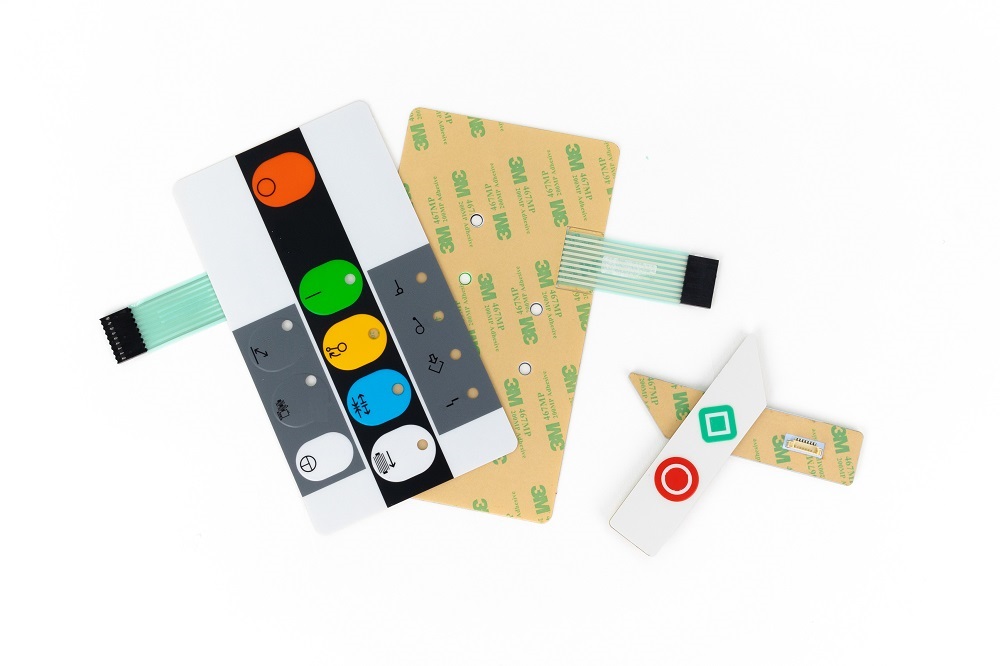Membrane Switch: A Comprehensive Guide to Its Uses and Applications
Membrane Switch: A Comprehensive Guide to Its Uses and Applications
Blog Article
Comprehending Membrane Layer Switches: The Trick to Trusted and resilient Controls

What Are Membrane Switches?
Membrane switches are an advanced remedy in the world of user interface innovation, integrating capability and design perfectly. These gadgets serve as a user interface in between customers and digital systems, incorporating numerous components into a compact style. Commonly built from versatile, thin layers of materials, membrane switches are developed to respond to touch, allowing individuals to engage with machinery and electronic gadgets efficiently.
The main aspects of a membrane switch consist of a published circuit layer, visuals overlay, and a spacer layer that stops unexpected activation. The visuals overlay can be personalized to show brand identity or customer choices, improving appearances while making certain use. Membrane layer switches are typically utilized in numerous applications, consisting of medical devices, customer electronic devices, and industrial devices, owing to their durability and resistance to ecological factors such as moisture and dirt.
Among the vital benefits of membrane buttons is their capability to stand up to wear and tear, making them perfect for high-traffic settings. Furthermore, they are lightweight and call for very little space, enabling ingenious designs in item advancement. Overall, membrane layer switches stand for a effective and practical choice for modern digital interfaces, weding innovation with user-centric layout principles.
Just How Membrane Switches Over Work
The procedure of membrane layer switches hinges on a straightforward yet effective system that equates customer input into electronic signals. When an individual presses the button, the leading layer deforms, enabling a conductive aspect in the circuit layer to make call with a corresponding conductive pad on the underside of the graphic overlay.
The style of membrane layer buttons can differ, yet they frequently integrate domes or responsive components to provide feedback to the individual, improving the total experience - membrane switch. The products made use of in membrane layer switches, such as polyester or polycarbonate, contribute to their toughness and resistance to ecological factors, including moisture and dust. The published circuits are commonly enveloped, which shields them from wear and tear over time.
Advantages of Membrane Layer Buttons

Furthermore, membrane layer buttons are recognized for their durability. Constructed from robust materials, they are resistant to dust, wetness, and physical wear, which substantially expands their life-span contrasted to typical mechanical buttons. This durability makes them particularly suitable for high-traffic atmospheres and applications needing durability.
One more considerable benefit is the ease of cleaning and maintenance. The smooth surface area of membrane layer switches over decreases dirt build-up and is commonly invulnerable to spills, making them suitable for setups that need regular sanitization.
Furthermore, membrane buttons supply a structured profile, resulting in a thinner design that can be integrated right into different tools without including bulk. This feature not just improves the aesthetic appeal yet likewise contributes to a more ergonomic item style.
Applications of Membrane Buttons
Easy to use and flexible, membrane layer switches discover applications across a vast array of industries, consisting of clinical devices, customer electronics, and industrial devices. In the medical area, these buttons are integral to tools such as diagnostic devices, patient tracking systems, and infusion pumps, where integrity and ease of cleansing are essential. Their capability to hold up against rough atmospheres and maintain functionality makes them ideal for such applications.

In consumer electronic devices, membrane buttons are utilized in products like microwaves, washing devices, and remotes - membrane switch. Their smooth style enables for instinctive interface, improving the overall individual experience while giving resilience and resistance to use and tear
Commercial tools additionally gains from membrane layer buttons, specifically in control panels for machinery and automation systems. These switches offer security versus dust and dampness, ensuring regular efficiency in tough atmospheres. Additionally, their go to this site customizable features permit producers to tailor them to certain functional demands, improving efficiency and capability.
Choosing the Right Membrane Layer Change
When picking a membrane switch, it is vital to take into consideration numerous variables that influence performance and suitability for particular applications. The key considerations consist of environmental problems, responsive comments, durability, and style requirements.
First, assess the operating atmosphere; switches subjected to wetness, chemicals, or severe temperature levels need certain materials to make certain durability and performance. Next, evaluate the demand for responsive responses. Relying on individual communication, some applications might take advantage of a tactile response to validate activation, while others might like a non-tactile layout for visual reasons.
Resilience is another crucial element; membrane layer switches ought to be designed to stand up to regular use, effects, and abrasion. Make certain the picked switch can sustain the anticipated lifecycle, specifically in high-usage circumstances.

Final Thought
In verdict, membrane changes work as vital elements in the layout of reputable and durable control systems throughout different industries. Their portable style, incorporated with durable construction and customizable features, enhances individual communication while making sure durability in requiring settings. The versatility of membrane layer changes enables tailored remedies that fulfill specific functional needs, reinforcing their value in modern-day innovation. As sectors remain to evolve, the value of integrating efficient membrane layer switch solutions can not be overemphasized.
Membrane switches over stand for a crucial aspect of contemporary interface layout, mixing functionality with durability in various applications.Membrane layer switches are a sophisticated solution in the realm of user interface technology, incorporating performance and design flawlessly. Normally built from adaptable, slim layers of products, membrane buttons are designed to react to touch, making it possible for individuals to engage with machinery and digital tools Click Here successfully.
The style of membrane layer buttons can vary, but they often include domes or responsive aspects to provide comments to the individual, enhancing the useful site overall experience.In conclusion, membrane layer switches over serve as important elements in the style of trustworthy and resilient control systems across numerous industries.
Report this page